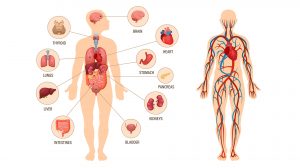
System
n., plural: systems
[zʏsˈteːm]
Definition: A group of related or interdependent unified objects or components of a whole
Table of Contents
A system pertains to interdependent or interrelated objects comprising and functioning as a whole. In biology, it may refer to the biological or body systems. A biological system is a group of organs that work together to carry out a particular task. In humans, there are different body systems that are comprised of biological organs with specific functions. Another biologically-relevant concept is the classification system, which is a collection of procedures, characteristics, and definitions used to classify and/or identify living things.
System Definition
What does a “system” mean? The word “system” is derived from the Latin word “systema”, which describes the relation between several working elements or units. Systems are built to produce one or more specific goals. In our daily life, we come in contact with various systems, such as the accounting system, the transportation system, the computer system, and so on. There are many ways to define a system; however, a common definition is that a system is an entity consisting of grouped components that are connected together according to a specific plan in order to achieve a certain outcome. Components of a system may be physical, coordinated steps, or multi-structure. Accordingly, a system must achieve the following criteria:
- A system is created to give a predetermined outcome
- The main and central outcome of the system has a priority over the outcome of each subsystem.
- The components of the system must be interdependent. Although these components (subsystems) can function alone with distinct outputs and inputs, they have to be incorporated into a system. Otherwise, the system will not be as functional or efficient.
What is a simple definition of a system? We can define a system as a group of components or subsystems that integrate and function together in order to achieve a specific goal. For example, a disk subsystem is a component or part of a computer system. Any system has different system components starting with inputs that undergo processing in the system to produce outputs. Inputs and outputs represent the final goal of the system. Therefore, most systems are composed of many small systems or subsystems that may either be simple or complex components.
Biological body systems are a primary example. The human body is comprised of various biological systems. The digestive system, for instance, is a system made up of distinct organs (such as mouth, stomach, intestines, accessory organs, etc.) for a specific goal — to digest food.
A system refers to the interdependent or interrelated objects comprising and functioning as a whole, such as a biological system and a classification system. A classification system is A system for classifying organisms. Etymology: Latin systēma, from Ancient Greek σύστημα (sústēma).
What is the synonym of a system? Another word for a system is a structure. Another system meaning is organization. It refers to the presence of different elements structurally organized together to serve as a whole (or a unit).
Components of a General System
A system has different components or subsystems. Each subsystem has its own inputs, outputs, components, and goals that altogether serve the main system in achieving an ultimate outcome.
Inputs are elements used by several systems to obtain the final output. In general, inputs may be in the form of money, facilities, equipment, supplies, people, time, and ideas. For example, in the system with the desired outcome of training students, inputs will be children, trained teachers, training materials, papers, pencils, funding, and classrooms. In order to achieve the final outcome – which is to train children. Inputs might affect the quality of services and products since the cost of inputs identifies them and they influence the final outcome of the process.
Outputs are results obtained from each system. They are produced as a result of the interaction of the system with inputs. Outputs are often calculated using numbers. Going back to the above example, the output of the training system can be calculated by the number of children who finished the training program. However, the number of outputs is not enough to assess the quality of outputs. Instead, The accomplishment of a certain goal should be the final assessment of the ultimate result we want to get from a system. These goals are usually described as missions, accomplishments, or purposes achieved by the system.
A successful system ensures the integration and alignment among its different parts by exchanging information between its different components. Consequently, if any part of the system is not highly functioning or weakened, it is adjusted again to give the required outcome of the whole system. For example, if a tire of a moving car has a defect, the whole car will not perform its function properly.
Types of Systems
Even though there are many types of different systems, they share a common characteristic: all systems are composed of different elements that function together as a whole while maintaining their own identity. Systems may be natural such as ecological systems or artificial (made by man) such as computer systems. They may also be open or closed. Complex systems are usually open systems because they interact with their environment.
Natural vs. artificial systems
Systems can either be natural or man-made. Natural systems do not usually show a distinct output. However, they are essential for life on Earth. In contrast, man-made or artificial systems are designed to give a certain outcome using related elements that can achieve some actions serving the whole system. An artificial system design must be similar or close to other pre-existing systems to avoid system failure. Moreover, a slight modification to the system must be assessed and studied before application. All components of the system must be periodically evaluated to detect the system’s defects and ensure the production of the desired outcome. Below is a video comparing natural and artificial ecosystems as an example of contrasting systems found in nature and an artificial system (designed by humans).
Open vs. closed vs. isolated systems

Another classification of a system describes systems as open, closed, or isolated. Open systems exchange energy and matter with the surrounding environment, such as boiling water in an uncovered pot. There is an exchange of heat and water vapor with the surrounding air.
Closed systems exchange only energy with the environment, such as boiling the water in a tightly covered pot. It will exchange heat only but not water vapor.
The isolated system does not exchange energy or matter with the surrounding environment. An example would be is a thermos containing hot water. There is no exchange of heat and water vapor between the air and the thermos. The hot water is contained; energy and matter inside the container (thermos) cannot escape and no energy or matter cannot enter through it, and thus the system is isolated.

Living organisms represent an open system since they exchange both energy and matter with the environment. If a human breathes, he releases gases into the environment (matter) and releases heat (energy). Earth is an example of a closed system. Solar energy enters the Earth’s system but no Earth’s matter leaves the planet. They are cycled back to the Earth. Read: Carbon Cycle, The Water Cycle, Nitrogen Cycle. As for the isolated system, an example would be the universe.
System Examples
What is a system and what are the examples? A system is a structure composed of related components that serve in a group to give the final output.
The Solar System
The solar system is the system in the universe where the Earth belongs. The mass of the solar system is found mainly in the sun followed by Jupiter. All planets of the solar system orbit in definite paths similar to discs. The solar system does not only contain the sun and planets but also small rocks, especially those found between Jupiter and Mars (called the asteroid belt). Let’s take a closer look at the Earth’s systems.
Earth systems
The Earth has four main types of systems: (1) geosphere (land system), (2) hydrosphere (water system), (3) atmosphere (air system), and (4) biosphere (life system). The geosphere represents the land and rocks. It forms the external surface and internal structure of the earth, which is made of rocks and minerals. The hydrosphere represents all the water present on the Earth’s surface including salty and freshwater. The major portion of the hydrosphere is saline water (96.5%), which some animals and humans cannot drink if not processed. About three-quarters of the freshwater on earth is found in the form of ice and water vapor while the remaining portion is present in rivers and lakes. The atmosphere is a mixture of gases including oxygen, nitrogen, and to a lesser extent water vapor, hydrogen, ozone, carbon dioxide, and argon. The atmosphere is essential for the existence of life. The atmospheric gases provide protection from the harmful ultraviolet rays of the sun. It also keeps the temperature of the earth in a range suitable for life. Thus, it contributes to the survival of life on Earth.
The biosphere is the living part of the Earth. It includes all living organisms — from unicellular bacteria, archaea, and protists, to multicellular fungi, plants, and animals. The geosphere, hydrosphere, and atmosphere provide an ecosystem to various life forms on Earth.
Earth’s systems are integrated together. They are overlapping so if one system is affected it affects other systems as well. For example, when air (atmosphere) is saturated with water particles (hydrosphere), it rains on the surface of the earth (geosphere).
Raining or snowing may promote erosion of rocks where large rocks are broken down into smaller ones. Consequently, the shape of these large rocks or mountains is changed.
On a larger scale, the interconnection between the Earth’s systems may cause natural phenomenons, such as tsunamis, volcanic eruptions, changes in the chemistry of some oceans, and alterations in the components of the atmosphere. The microbial diversity of the soil may also be altered through time. Human activities, in particular, impact the Earth systems. Burning fossil fuels, for example, causes greenhouse gases (carbon dioxide) to get trapped in the atmosphere. This contributes to global warming and climate change. Improper disposal of wastes has also been the primary factor of pollutions. Read: Pollution in Freshwater Ecosystems – Biology Online Tutorials
Ecological systems
Ecological systems or ecosystems are systems consisting of biotic and abiotic components that function together as a unit. Biotic components are the living organisms whereas the abiotic components include all the non-living components in a system. These living and non-living components are connected together by energy flows and nutrient cycles.
Read: Freshwater Community Energy Relationships – Producers & Consumers
Energy obtained from the sun enters the ecosystem through photosynthesis performed by different plants and algae. Animals feed on plants or on each other. Animals contribute to the flow of energy throughout the system. Moreover, they affect the number of plants and microbes in the system. Decomposers break down dead matter releasing its content in a simpler form in the soil and atmosphere to be used again by plants and microbes.
Ecosystems are influenced by several internal and external factors. Internal factors are exemplified by shading, decomposition, and species present in the system. External factors, in turn, are exemplified by the various materials that form the soil and the atmosphere. For instance, climate affects the structure of an ecosystem by influencing the temperature and the extent of rainfall. It will therefore be a limiting factor as to which organisms can thrive and survive. It determines the availability of energy and water in an ecosystem. As such, it would have also an effect on photosynthesis and, subsequently, on the energy flow within the ecosystem.
Apart from climate, another important factor is the materials with which the soil is formed as they will determine the abundance, and therefore, the availability, of minerals and nutrients. The abundance or shortage of one element of an ecosystem affects the other elements. For example, the availability of nutrients in an aquatic ecosystem affects the production of algae. Thus, it consequently affects the abundance of animals that use algae for nutrition.

Biological systems
Biological systems (definition) are systems that are made up of different entities, such as bodily organs. Organs differ in their actions and structures according to the desired outcome of each system. Examples of bodily systems are the respiratory system, digestive system, and circulatory system. The human body consists of the following bodily systems:
- Respiratory system – responsible for one of the vital functions in any living organism, breathing, and gas exchange. The respiratory system consists of the two lungs which are the main respiratory organs, the pharynx, the larynx, the bronchi, and the diaphragm.
- Digestive system – intakes, digests, absorbs food and nutrients. It breaks down the complex food material into simpler molecules by which the body can benefit from in its different metabolic actions as well as obtaining energy. Moreover, it is responsible for the excretion of wastes. The digestive system is made up of salivary glands (secrete saliva for digestion), esophagus, stomach (stores and digests food), liver, gallbladder (secretes bile responsible for the digestion and breaking down of fats), pancreas (secretes the pancreatic juice), intestines (where most food materials are digested), rectum and anus (responsible for excretion of wastes).
- Cardiovascular system – delivers blood containing water, nutrients, and oxygen to all body organs and tissues. Also, it is responsible for collecting wastes from peripheral cells and transporting them to specialized excretory organs. It also contributes to maintaining body temperature and pH. The circulatory system is vital to all other body systems. It is made up of the heart that pumps blood throughout the whole body, blood, and blood vessels.
- Urinary system – responsible for urine excretion and balancing electrolytes and fluids in the body. It consists of the two kidneys, ureters, the bladder, and the urethra.
- Skeletal system – responsible for the protection and structural support of the body as well as the production of different blood cells from the bone marrow. The skeletal system includes bones, ligaments, tendons, and cartilage.
- Endocrine system – one of the most essential systems of the body as it controls the homeostasis, growth, and metabolism functions of the body through communicating with different parts of the body via the action of different hormones, such as thyroxin, corticoids, sex hormones, and other hormones secreted from endocrine glands including the adrenal gland, thyroid gland, and parathyroid glands.
- Lymphatic system – responsible for transferring lymph between the blood and tissues. It includes the vessels, tonsils, thymus, spleen, lymph nodes, and lymph. The lymphatic system has an immune function so it protects the body against invading pathogens and foreign bodies.
- Nervous system – sends signals through nerves to all body cells and collects information from peripheral nerves when they are exposed to different stimuli to be processed in the brain. It is composed of the brain, spinal cord, and peripheral nerves.
- Reproductive system – responsible for gamete formation and reproduction. It includes the sex organs of males and females.
Classification systems
In a general sense, a system pertains to a group of related or interdependent unified components of a whole. Another biologically relevant concept is the classification system. A classification system is a system for classifying organisms. It is a collection of procedures, characteristics, and definitions used to classify and/or identify, living things. As proposed by Carl Woese, living things are classified into three major domains: the Archaea, the Eubacteria (true bacteria), and the Eucarya (Eukarya). Below the domain are other major taxonomic ranks. These taxonomic ranks are kingdom, phyla, class, order, family, genus, and species. The branch of biology that studies the naming, arranging, classifying, and describing of organisms into groups and levels is taxonomy.
Both Domains Archaea and Eubacteria include prokaryotic organisms. They differ, however, in their genes and certain metabolic pathways. In essence, archaea although similarly prokaryotic as the bacteria possess genes that indicate that they are more closely related to eukaryotes than bacteria.
Eukaryotes are organisms that belong to the Domain Eucarya. Unlike prokaryotes, eukaryotes have a nucleus and other organelles, such as mitochondria, Gogi apparatus, and endoplasmic reticulum, inside the cell. Within Domain Eucarya, the organisms are further classified into these groups: protists, fungi, plants, and animals.
Protists are unicellular organisms although some of them may appear multicellular because they form colonies. Protozoans, algae, slime molds, and water molds belong to this group. Fungi are mostly multicellular organisms. They occur as filaments (hyphae) that form structures called mycelium. They are saprophytic and nonphotosynthetic. Mushrooms, mildews, and puffballs are examples of fungi. Yeasts are also fungi but they are single-celled organisms. Plants are autotrophic eukaryotes. They possess chlorophyll (green pigment) that enables them to capture and use light energy for food production (photosynthesis). Animals are heterotrophic eukaryotes. They are multicellular organisms that rely on other organisms for nutrients as they do not have the ability to produce their own food as plants do. Humans belong to the animal group. Below is an example of human taxonomy.

Try to answer the quiz below to check what you have learned so far about systems.
References
- Burgot, J. L. (2017). Thermodynamic Systems. In The Notion of Activity in Chemistry (pp. 3-10). Springer, Cham.
- Dickinson, G., & Murphy, K. (2007). Ecosystems. Routledge.
- McNamara, C. (2017). Field guide to consulting and organizational development with nonprofits.
- National Geographic Society. (2012, October 09). Ecosystem. Retrieved February 09, 2021, from https://www.nationalgeographic.org/encyclopedia/ecosystem.
- National Geographic Society. (2019, September 11). Earth’s systems. Retrieved February 09, 2021, from https://www.nationalgeographic.org/article/earths-systems/
- Pimm, S. L. (1984). The complexity and stability of ecosystems. Nature, 307(5949), 321-326.
- System. (n.d.). Retrieved February 09, 2021, from https://www.merriam-webster.com/dictionary/system
- The laws of thermodynamics (article). (n.d.). Retrieved February 09, 2021, from https://www.khanacademy.org/science/ap-biology/cellular-energetics/cellular-energy/a/the-laws-of-thermodynamics
- Types of systems. (n.d.). Retrieved February 09, 2021, from https://www.sebokwiki.org/wiki/Types_of_Systems
©BiologyOnline.com. Content provided and moderated by BiologyOnline Editors.








